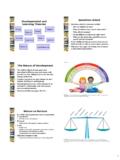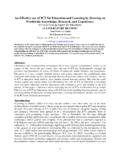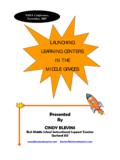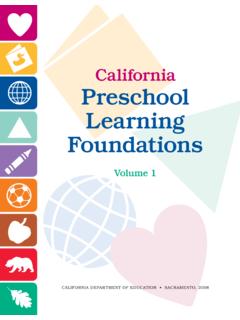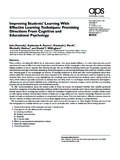Transcription of Myths about Teaching and Learning Second …
1 TESLR eporter37,2(2004), pp. 1-13 Myths about Teaching andLearningSecondLanguageVocabulary:What RecentResearch SaysKeith S. FolseUniversityofCentralFlorida,USAI ntroduction1 Learninga languageentailslearningnumerousaspectsab outthatlanguage,includingitspronunciatio n,writingsystem,syntax,pragmatics,rhetor icalmodesforreadingandcomposition,cultur e,andspelling, (L2)researchreflectsthisimportance,assee nin ( ,naturalcontextordirectinstruction)(Lauf er&Shmueli,1997;Zimmerman,1997),learners 'vocabularylearningstrategies(Gu,1994;Le ssard-Clouston,1994;Sanaoui,1995;Nassaji ,2003),thedevelopmentofL2learners'vocabu laries(Laufer,1998;Schmitt,1998;Nesselha uf,2003),the useofLlor L2 forinitialwordpresentation(Prince,1995;G race,1998),theeffectofdifferentpracticea ctivitiesonlearning(Joe,1995,1998;Folse, 1999),thenumberofwordsL2learnersneedtokn ow(Hazenberg&Hulstijn,1996),andwhichword sstudentsneedtoknow(Coxhead,2000;Liu,200 3).
2 Thefindingsofthesestudiescastdoubtoncomm onmythsaboutL2vocabularyteachingandlearn ing(Folse,2004b).Thispaperfocuseson thefollowingeightmyths:(1)Vocabularyis not asimportantinlearninga foreignlanguageasgrammarorotherareas.(2) Itis notgoodto uselistsofwordswhenlearningvocabulary.(3 )Vocabularyshouldbepresentedinsemanticse ts. (4) Theuseoftranslationsis apoorway tolearnnewvocabulary.(5)Guessingwordsfro mcontextis asproductiveforforeignlanguagelearnersas it is forfirstlanguagelearners.(6) Thebestvocabularylearnersmakeuseofonlyon e or twoeffectivespecificvocabularylearningst rategies.(7)Foreignlanguagelearnersshoul duse amonolingualdictionary.(8) thisarticle,I 1 Vocabulary is Not asImportantinLearninga ForeignLanguageasGrammaror Other AreasComprehensible input helps learners figure out how a language that a learner is hearing or reading has many unknown words, then that languageis not comprehensible and therefore cannot be words, without vocabulary,comprehensible input is neither comprehensible nor input.
3 Adult ESL learners are keenlyaware of their "vocabulary plight." Learnersneedvocabulary and see acquisition ofvocabulary as their greatest challenge (Green&Meara, 1995; Meara, 1980).Two of the mostimportantskills foracademic-boundESL students are readingand writing. TherelationshipbetweenL2vocabularyknowle dgeand L2 readingability is clear (Haynes, 1993; James, 1996). Huckin&Bloch (1993) point out,"Researchhas shown thatsecond-languagereaders rely heavily onvocabularyknowledge,and that a lack ofvocabularyknowledgeis the largest obstacle for Second -language readers toovercome"(p. 154). Haynes and Baker (1993) found the mainobstacle for L2 readers not to be a lack of reading strategies but ratherinsufficientvocabularyknowledgein English. Laufer&Sim (1985) list these areas in order ofdecreasingimportancein reading ability in L2:knowledgeof vocabulary, subjectmatter, discourse markers, and syntactic , Laufer and Sim find thatvocabularyis most important, syntax least its role in L2 reading, a large L2 vocabulary base can have a significanteffect onlearners'writing skills (Laufer, 1998) and in listening and speaking tasks (Joe,1995).
4 Though correlation does not imply causality, empirical studies have shown thatgood L2 readers, writers, speakers, and listeners know much more far too long, the emphasis in ESL hasmistakenlybeen on grammar. Learnerscan expressthemselveswith poor grammar; in fact, much to the chagrin of ESLteachers,they do this ,withpoorvocabulary,communicationisconst rainedconsiderably. You can get by without grammar; youcannot get by without a foreign language learner in Latin America, Saudi Arabia, Malaysia, andJapan, I managed quite well with limited grammar; however, my worst and (inhindsight) sometimes funniestcommunicationbreakdownexperience swere when Idid not know theappropriatevocabulary. On one occasion, I spent a long and tryinghour in a small store in Japan trying topurchaseflour without knowing the word forflourin Japanese.
5 Icouldn'tdraw it. Icouldn'texplain it. At one point, I even triedsaying"pre-bread,"but thatjustproducedmore looks of end, I leftFolse-SecondLanguage Vocabulary Myths3the storewithoutthe flour. I hadmasteredbeginninglevel polite forms for"Excuseme, where is the__'l"but I did not know theJapaneseword forflourto fill in thatkey blank ofgrammarknowledgecan limitconversation;lack ofvocabularyknowledgecan UseListsofWordsWhenLearningVocabularyUsi ng lists may be boring for some learners, but there is noevidenceto show thatlearnersdo not fare well with lists, nor is thereempiricalevidencethatstudentswithou tlists farebetterthan those with lists. In fact, some learners prefer be due to theireducationalbackgroundwhich relies heavily on rote Learning , or it could also be due toindividuallearner the reason, studentscanlearn from simple vocabulary lists can yield better vocabulary retention than relying on listswith more information, , example sentences.
6 In a study of Hebrew speakers studyingEFL, Laufer and Shmueli (1997) compared four modes of presentation, including lists: (I)words presented in isolation, (2) words in minimal context, , in one meaningful sentence,(3) words in text context, and (4) words in elaborated text context. Results showed that lessinformation was better. Retention scores for word recognition were superior when lessinformation or limited context was given about the word (as in modes 1 and 2) and inferiorwhen more information or extended context was given (as in modes 3 and 4).Inanotherstudy on the use of lists in Learning L2 vocabulary, Prince (1995)examinedthe role oflearners'L2proficiencyand mode ofpresentation, ,Lltranslationsor L2context(in a series of L2 sentences).Prince found that lessproficientstudents were able to recall more items when they hadlearnedthe words inthetranslationconditionrather than in ,thisresearchshowed that some studentsperformbetterwhen they were given only a list of L2words and because a list can be effective does not mean that teachers should hand a list tostudents and ask them to learn the list.
7 The content of the list is the target, and it is up tothe teacher to come up with ways to present sections of the list to students in interesting,meaningful ways and then provide relevant oral and written practice good lists exist fordifferenttypes of learners. Very young learners mightbenefitfrom the Dolch list, which is a list of 220 sight words, socalledbecausethesehigh frequency words do not follow the basic rules ofEnglishphonics and mustthereforeberecognizedby sight, not bysoundingthem out. The list waspreparedin4 TESLR eporter1936 but is still relevant; it includes mostly function words and isespeciallyuseful forkindergarten to middleelementarylevel promising lists for adult learners are the University Word List (UWL) and theAcademic Word List (AWL).Publishedin 1984, the UWL consists of 808 words thatoccur frequently in academic text materials.
8 The AWL,publishedin 1998, consists of570 word families ( ,concentratealsoincludesconcentrated,con centrates,concentrating,andconcentration )that occur in a wide variety of types of academictext materials. (Both lists can beobtainedon theInternetthrough a simple search.)Myth3 Vocabulary Should bePresentedinSemanticSetsResearch does not tell us what the best way to organize new vocabulary is, but itcertainly speaks to what a bad way is: The commonly used organization of words intosemantic groups is not a good technique. In fact, it actually confuses learners and canhinder vocabulary retention. Organization by semantic sets continues, however, becauseit is much easier for textbook writers and teachers to present vocabulary in semantic setssuch as family members, animals, or days of the week than design creative vignettes toaccommodate all of the words in a vocabulary list.
9 The bottom line, though, is thatresearch shows that learners remember vocabulary more easily when the vocabulary ispresented in thematic sets such as a trip to the beach or my cousin's birthday is a simpleexampleof how words from the semantic setsoffamilymembers,animals, and days of the week could bedistributedinto the thematic set of a trip to thebeach:Last Saturday I went to the beach with my brother and cousin. My brotherwanted to take his pet bird with us, but my cousin and I talked him outofsuch a crazyidea. My cousincalledhis parents to make sure it was all right for him to go with they said yes. We had a great time at the beach. We saw we got home Saturday night, we talked about going to the beachagain on Sunday. We we really tired, so wedecidedto get up late on Sunday this very brief passage, which would have follow-up questions that would alsopromote frequency of vocabulary retrieval for the learners, two days of the week arementioned(Saturday, Sunday),two animals arementioned(cat,fish),and three familymembers arementioned(brother, cousin, parents).
10 Thispresentationmay also besuperior because the itemspresentedare higher frequency than other semantic setmembers (Saturday and Sunday are more frequent than Wednesday andThursday)andbecause they are in frequentcollocations(Saturday and Sunday, Saturday night,Sunday morning).Folse-SecondLanguageVocabularyM yths5 Theresearchfindings here are quite (1993) found thatlearnershad moredifficultylearningnew wordspresentedto them insemanticclustersthanthey didlearningsemanticallyunrelatedwords. In areplicationusing onlyJapaneselearners,Waring (1997) found thatlearnersneededabout 50% more time to learnrelatedword pairs (1997) found thatsemanticgroupingactually had anegativeeffect onvocabularylearningwhilethematiccluster ingfacilitatedlearning. Similarly, Olsen (1999) found thatNorwegianEFLlearnersweremore easilyconfusedwhendifficultpairs such asseaandseeorwantandwon'twerepresentedat the same ofTranslationsis aPoorWaytoLearnNewVocabularyLet me be clear: I am notadvocatinga returnto doubt,teachersneed toencouragethe use of the targetlanguagein theclassroomforall ,whenlearnersfirstencountera new word, it isnormal for them totranslatethe word in their head or in their myth is thatstudentsmust learn newEnglishwords in English, as ifestablishinga mental link with thattranslationis not only whatlearnerspreferbut also have shown the valueofLltranslationsinvocabulary-learni ngactivities(Hulstijn,1992;Knight,1994;P rince,1995; Chun &Plass, 1996;Laufer&Shmueli,1997; Grace, 1998;Laufer&Hulstijn,1998).
